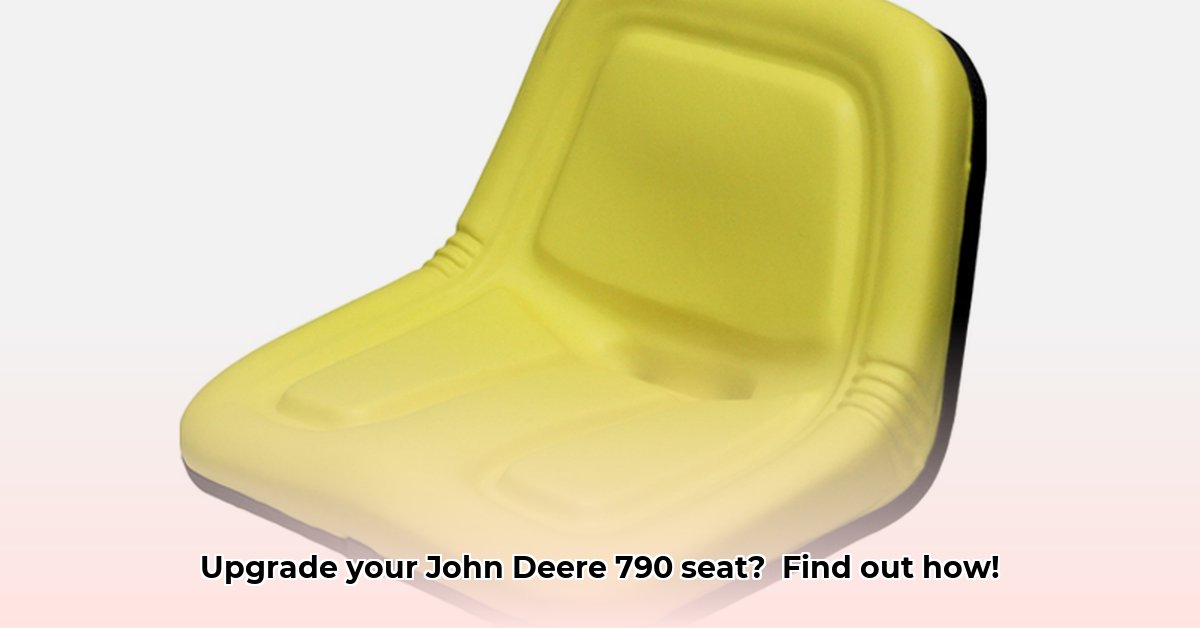
Upgrading Your John Deere 790 Tractor Seat: A Comprehensive Guide
Upgrading your John Deere 790 tractor seat can significantly improve comfort and operator efficiency. However, finding a compatible replacement can be challenging due to variations in seat dimensions and mounting patterns. This guide provides a step-by-step process to help you select and install a suitable replacement seat, ensuring a comfortable and productive farming experience. Are you ready to transform your tractor driving experience? For more options, check out this helpful resource on replacement tractor seats.
Measuring Your Existing Seat: Precision is Key
Accurate measurements of your current seat are crucial for finding a compatible replacement. Use a tape measure and follow these steps:
- Width: Measure the widest part of the seat base (the area where your bottom rests). Measure straight across.
- Depth: Measure from the front to the back edge of the seat base.
- Height: Measure the height of the seat pan from the mounting surface to its top.
- Mounting Hole Pattern: This is critical. Measure the distance between each mounting hole, both horizontally and vertically. Draw a diagram of the hole pattern, labeling all measurements. Note the overall shape (square, rectangular, etc.).
Accurate measurements are essential for a seamless upgrade. Have you taken your measurements yet? This critical step influences the success of your upgrade project.
Identifying Compatible Aftermarket Seats: Navigating the Options
Armed with your measurements, you can now explore aftermarket options. Manufacturer claims of "John Deere 790 compatibility" should be treated with caution. Instead, focus on matching the precise dimensions of your existing seat.
Key factors to consider:
- Exact Dimensions: The aftermarket seat's width, depth, and height should closely match your measurements. Slightly smaller is usually acceptable, but larger will likely cause problems.
- Mounting Hole Pattern: The new seat's mounting hole pattern must precisely match your tractor's. Even minor discrepancies can prevent installation. Your diagram from the previous section will be invaluable in this process. Always confirm compatibility with the seller.
A well-defined and measured approach ensures that you invest in a seat that truly fits your model. A minor sizing difference can compromise the comfort and productivity of your farming operation.
Addressing Fitment Issues: Adapters and Custom Solutions
Despite careful measurements, you might encounter fitment issues. Here are some solutions:
- Adapter Plates: Adapters can bridge gaps between different mounting patterns. Understand that this requires some mechanical skill.
- Custom Fabrication: For complex issues, custom fabrication could be necessary—but this involves welding and metalworking, best done by a professional.
How likely is it that you'll need adapter plates or custom fabrication? This depends heavily on the accuracy of your measurements and the availability of perfectly matching aftermarket seats.
Installation: A Phased Approach
Installing your new seat is straightforward but requires careful attention to safety.
- Disconnect the Battery: Disconnect the negative battery terminal first to prevent electrical shorts.
- Remove the Old Seat: Carefully remove the bolts and connectors, taking photos as you proceed.
- Clean the Mounting Surface: Thoroughly clean the mounting area to ensure a secure fit.
- Install the New Seat: Align the new seat and securely attach it using the correct bolts. Double-check alignment.
- Reconnect Everything: Reconnect electrical connections and test seat functionality.
- Test and Adjust: Adjust the seat to your comfort and test for correct operation.
Following these steps diligently will contribute to a smooth and efficient installation process. Did you remember to disconnect the negative battery terminal first? Safety always comes first.
Troubleshooting Common Problems
Even with a perfect fit, minor problems might arise. Here's how to address them:
- Seat Adjustments: Consult your new seat's manual if adjustments aren't working correctly.
- Squeaks: Lubricate moving parts with an appropriate lubricant to eliminate squeaks.
- Vibrations: Excessive vibrations might indicate loose mounting. Re-tighten all bolts. If vibrations persist, your tractor's suspension system may require attention.
Addressing these potential issues is essential for a comfortable and operational seat. Have you prepared a checklist for troubleshooting? This is a proactive way to ensure a successful upgrade.
Frequently Asked Questions (FAQ)
Q: What are the most common reasons why an aftermarket tractor seat wouldn't fit?
A: Inconsistent sizing and mismatched mounting hole patterns are the most frequent culprits. Precise measurements are critical.
Q: Are adapter plates always a viable solution?
A: Not always. The complexity of the adaptation and the structural integrity of the resulting setup need careful assessment. In some cases, custom fabrication is a better option.
Q: How much should I expect to spend on a replacement seat?
A: The price varies significantly depending on the brand, features, and compatibility. Expect to spend anywhere from $250 to $700 or more.
This comprehensive guide provides actionable advice for a successful John Deere 790 tractor seat upgrade. Remember, precise measurements and careful selection are vital for a comfortable and productive farming experience.